
Orb-weaver spiders are members of the spider family Araneidae. They are the most common group of builders of spiral wheel-shaped webs often found in gardens, fields and forest. "Orb" can in English mean "circular", hence the English name of the group. Araneids have eight similar eyes, hairy or spiny legs, and no stridulating organs.

Gasteracantha is a genus of orb-weaver spiders first named by Carl Jakob Sundevall in 1833. The females of most species are brightly colored with six prominent spines on their broad, hardened, shell-like abdomens. The name Gasteracantha is derived from the Greek gaster (γαστήρ), meaning "belly, abdomen", and akantha (άκανθα), meaning "thorn, spine". Spiny-backed orb-weavers are sometimes colloquially called "crab spiders" because of their shape, but they are not closely related to the true crab spiders. Other colloquial names for certain species include thorn spider, star spider, kite spider, or jewel spider.
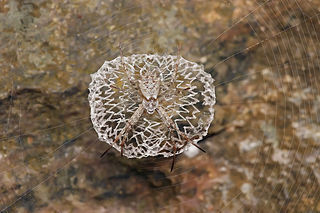
A web decoration or stabilimentum is a conspicuous silk structure included in the webs of some species of orb-web spider. Its function is a subject of debate.

A bolas spider is a member of the orb-weaver spider that, instead of spinning a typical orb web, hunts by using one or more sticky "capture blobs" on the end of a silk line, known as a "bolas". By swinging the bolas at flying male moths or moth flies nearby, the spider may snag its prey rather like a fisherman snagging a fish on a hook. Because of this, they are also called angling or fishing spiders. The prey is lured to the spider by the production of up to three sex pheromone-analogues.
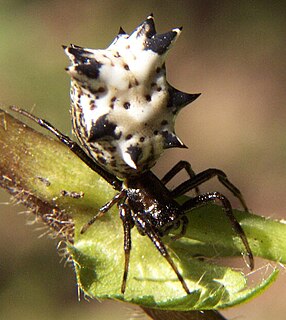
Micrathena gracilis is a spider in the family Araneidae (orb-weavers), commonly known as the spined micrathena or castleback orbweaver. This spider spins a moderately large and very tightly coiled web. The spiders themselves are small and can be found to be anywhere from 4.2 mm to 10.8 mm long. Its venom is not medically significant to humans, making it completely harmless. M. gracilis is unique in appearance due to its large spiky abdomen and black and white bodies. Certain spiders of this species can also display a yellow color on the sides of their bodies. These spiders can be seen most active during the end of the summer and beginning of fall. M. gracilis is diurnal and are rarely ever seen active at night.

Nuctenea umbratica, the walnut orb-weaver spider, is a species of spider in the family Araneidae.

Gasteracantha fornicata is a species of spiny orb-weavers found in Queensland Australia. It is similar in shape to Austracantha minax which was originally described as Gasteracantha minax. It was described by Johan Christian Fabricius in 1775, the first Australian species of spider to be named and classified.

Phonognatha graeffei, referred to as the leaf curling spider, is a common Australian spider found in woodlands and urban areas in the northeastern, eastern and southern states. A small member of the family Araneidae, the orb-weavers, it was previously placed in Tetragnathidae.

Phonognatha is a genus of South Pacific orb-weaver spiders first described by Eugène Simon in 1895. It was originally placed with the long-jawed orb weavers, and was moved to Araneidae in 2008.

Cyrtophora citricola, also known as the tropical tent-web spider, is an orb-weaver spider in the family Araneidae. It is found in Asia, Africa, Australia, Costa Rica, Hispaniola, Colombia, and Southern Europe. In 2000, it was discovered in Florida.

Argiope pulchella is a species of the orb-weaver spider family, Araneidae. It ranges from India to China and can be found on Java. It is a synanthropic species, often living in habitats associated with humans.

Neoscona domiciliorum, commonly known as the spotted orbweaver or redfemured spotted orbweaver, is a spider in the family Araneidae. The specific epithet domiciliorum means "of dwellings" in Latin and refers to the fact that this species is often found living on buildings. Their bites are not known to cause serious harm in humans.
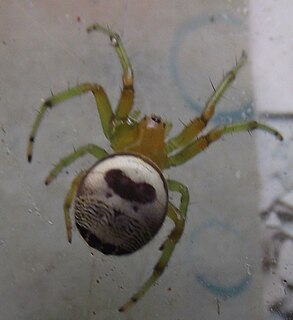
Araneus mitificus, commonly known as the kidney garden spider or pale orb weaver, is a species of orb-weaver spider found in South, East, and Southeast Asia.
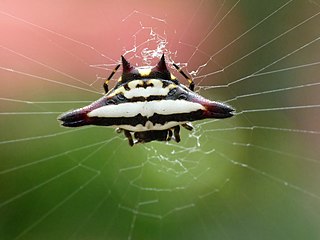
Gasteracantha geminata is a species of spider of the genus Gasteracantha, found in India and Sri Lanka. It is known as the oriental spiny orb-weaver.

Cyclosa turbinata is a species of orb weaver in the family of spiders known as Araneidae. It is found in a range from the United States to Panama, West Indies, Galapagos Islands, and has been introduced into Hawaii.

Artifex melanopyga, synonym Phonognatha melanopyga, referred to as a leaf curling spider, is a common Australian spider found in moist coastal areas of New South Wales and Queensland. A small member of the family Araneidae, the orb-weavers, it was previously placed in Tetragnathidae.
Artifex is a genus of South Pacific orb-weaver spiders first described by R. J. Kallal & Gustavo Hormiga in 2018. As of April 2019 it contains only two species.
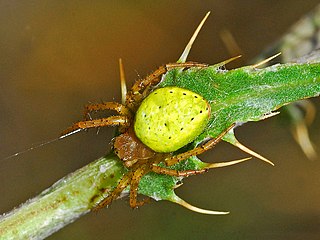
Araniella opisthographa is a species of orb weaver in the spider family Araneidae.
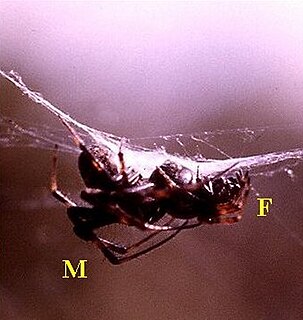
Metepeira incrassata, also known as the colonial orb-weaving spider, belongs to the spider family Araneidae and genus Metepeira. They are most famous for their social organization and group living behavior. They are generally found in tropical rainforest and agricultural sites in Mexico, and their habitats tend to be highly productive. Their group sizes are relatively larger than other colonial spiders, typically ranging from hundreds to thousands of individuals. 99% of the females are observed to participate in colonial living, generally with at least two other individuals. Because most M. incrassata females are communal, the colonies are often dominated by larger males. There is minimal sexual dimorphism observed in M. incrassata. Unlike other orb-weaver spiders, M. incrassata builds a colonial web by connecting each spider's individual webs together through semi-permanent framelines. These colonial webs of M. incrassata are prone to invasion by kleptoparasitic and araneophagic spiders such as the Theridiidae family. The reproductive cycle of M. incrassata occurs throughout the entire year, with multiple generations sharing the same time period. Within their colonies, M. incrassata is seen to change locations. Larger, fertile females with egg sacs prefer to reside in the central area of the group for increased protection from predators, while the younger spiders are mostly found in peripheral positions. Larger adult M. incrassata are also known to finish web-building earlier than smaller ones, gaining an advantage in strategically positioning themselves.

Cyrtarachninae is a subfamily of spiders in the family Araneidae. The group has been circumscribed in several different ways. It originated as the group Cyrtarachneae, described by Eugène Simon in 1892. The group was later treated at different ranks: as a tribe, both under Simon's name and as Cyrtarachnini, and as the subfamily Cyrtarachninae. Circumscriptions have varied. The broadest circumscription, Cyrtarachninae sensu lato (s.l.), includes three of Simon's original groups, including the bolas spiders. Unlike most araneids, members of the subfamily do not construct orb webs, some not using webs at all to capture prey, some using one or more sticky drops on a single line, while others construct webs with few widely spaced non-spiral threads, some triangular. Many have been shown to attract prey by producing analogues of insect sex pheromones, particularly to attract male moths. Adult females may mimic snails, bird droppings and other objects, and so are able to remain exposed during the day time, capturing prey at night.



















